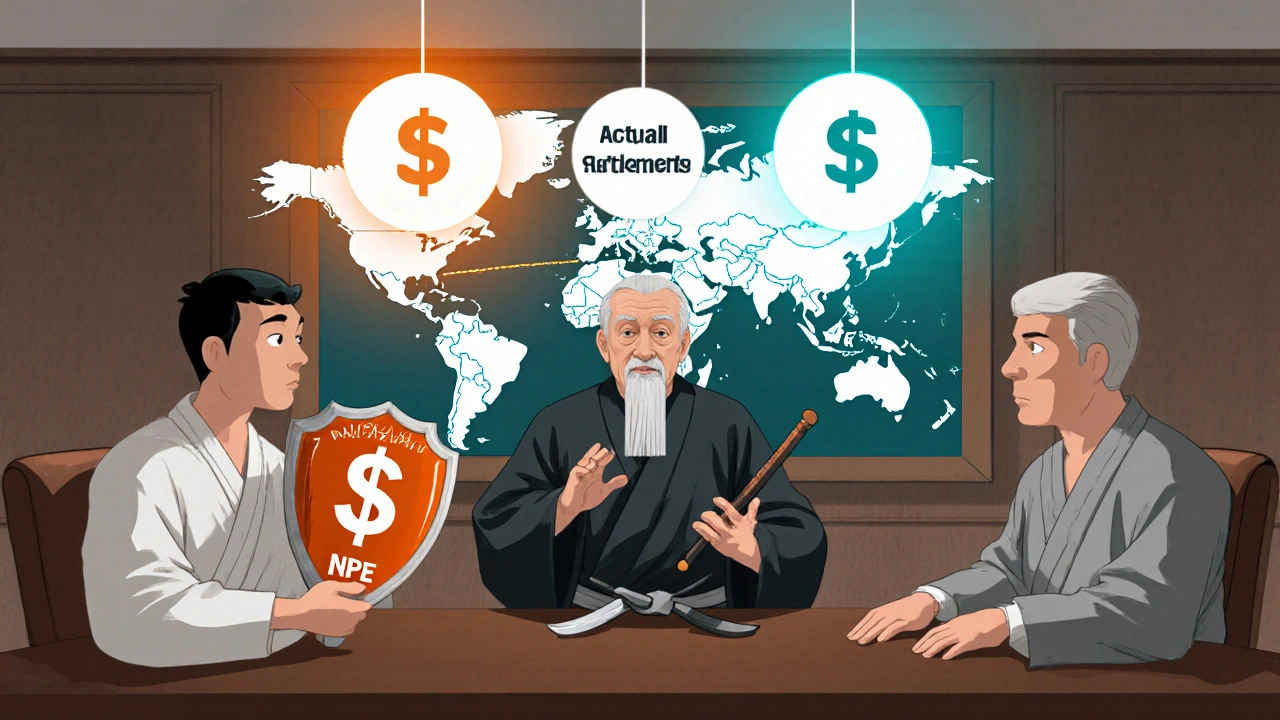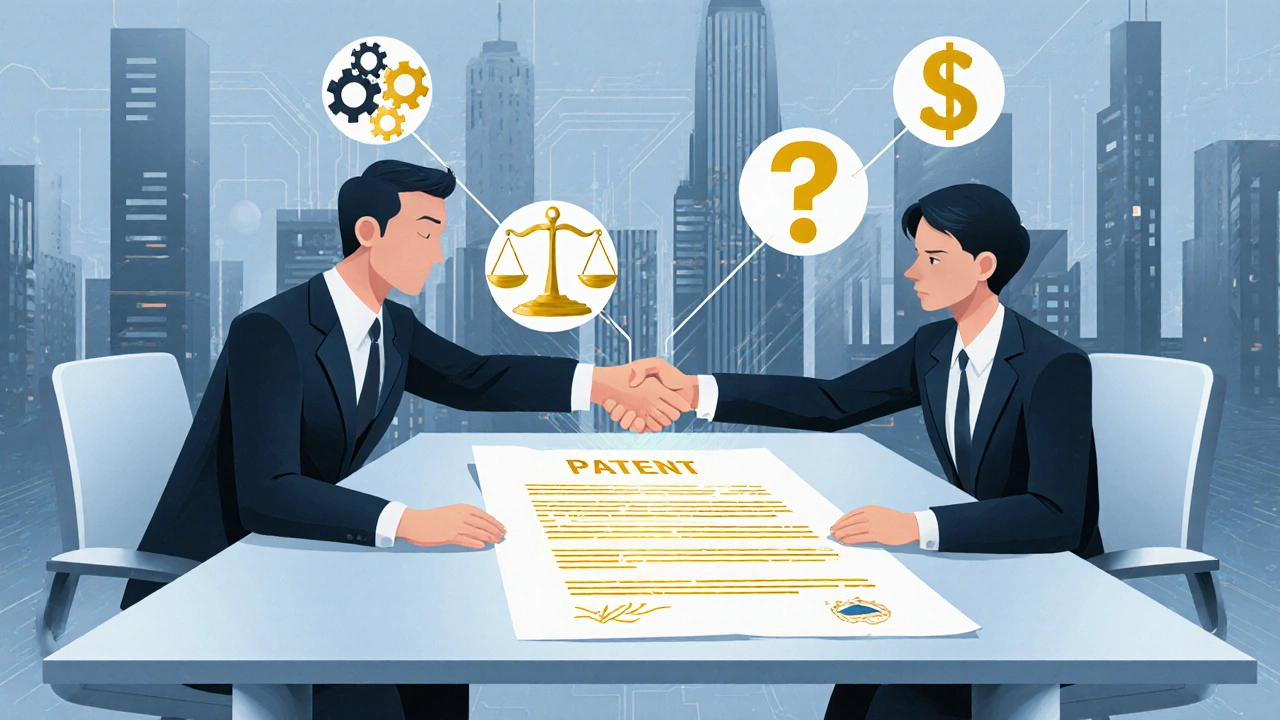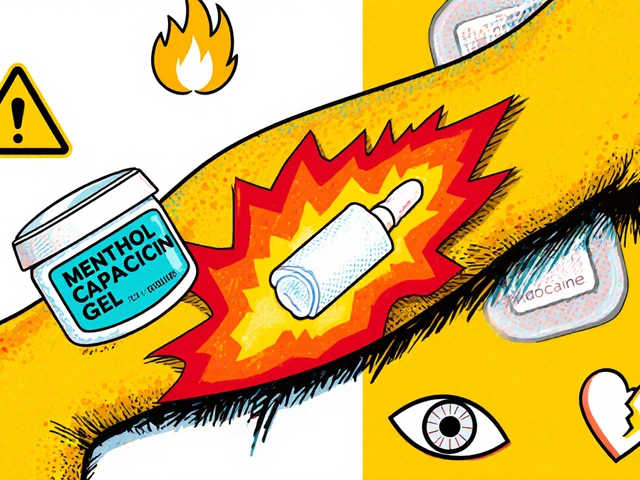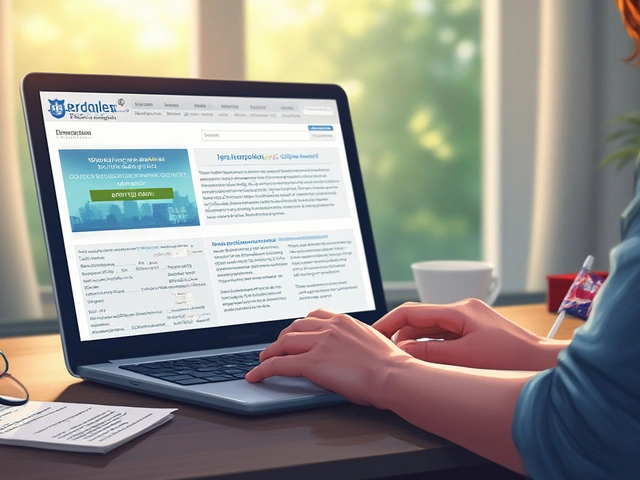When two companies clash over a patent, they don’t always go to court. In fact, most don’t. About 85.7% of patent disputes end in settlement before a single jury is seated. That’s not luck-it’s strategy. Companies negotiate entry not to avoid conflict, but to control it. They turn legal battles into business deals.
Why settle instead of sue?
Patent litigation is expensive. Going to trial can cost between $3 million and $5 million, even for cases where the damages claimed are under $25 million. For a small company, that’s a death sentence. For a big one, it’s a distraction. Time spent in court is time not spent innovating, manufacturing, or selling. Settlements let companies cut losses. They avoid unpredictable jury verdicts. They keep trade secrets out of public filings. And they often open doors to future collaboration. Intel didn’t just pay Samsung to drop a patent suit-they partnered with them afterward to co-develop 5G tech worth over $200 million in combined R&D savings.The anatomy of a patent settlement
A successful settlement isn’t just a handshake and a check. It’s a carefully constructed agreement built on four pillars: patent strength, financial terms, scope of use, and future obligations. First, both sides assess their patent portfolios. They don’t look at every patent-they pick 3 to 15 key ones that matter most. These are the patents with clear claims, strong enforcement potential, and relevance to current products. If a patent has already been challenged in a post-grant review and survived, it’s worth more. If it’s weak, it’s a bargaining chip. Next, they build claim charts. These are technical maps showing exactly how one company’s product uses the other’s patented invention. A claim chart isn’t legal jargon-it’s engineering evidence. It answers: Does this chip really use that algorithm? Does this drug formulation match the patent’s chemical structure? Then comes the money. Settlements come in three main flavors: lump sum, royalties, or cross-licensing. - Lump sum: One company pays the other a fixed amount-often $1 million to $10 million-depending on the industry and patent value. Non-practicing entities (NPEs) usually settle for $1.2 million on average. Competitors? More like $8.7 million. - Royalties: A percentage of sales, usually 1.5% to 5%. In telecom, where patents are essential to standards like 4G and 5G, royalties are tied to device price. Ericsson’s 2021 deal with Samsung included tiered royalties: 0.5% on low-end phones, up to 2.5% on premium models. - Cross-licensing: Both sides grant each other rights to use their patents. This is common in semiconductors and electronics. Apple and Samsung settled dozens of cases this way-each got access to the other’s tech without paying cash. It’s like trading tools instead of fighting over who owns the workshop.The high-low settlement trick
One of the smartest tactics in patent negotiation is the high-low structure. It was first used by Stanley Black & Decker in 2015 and has since become a favorite among large manufacturers. Here’s how it works: The two sides agree on a set of 2 to 5 key legal questions-like whether a patent is valid, or whether a product infringes. They then set two numbers: a high payment (if they win on all points) and a low payment (if they lose on all points). The actual payout falls somewhere in between, based on how many of those key issues they win. Why use it? It removes the all-or-nothing risk of trial. It forces both sides to focus on the most important claims. And it makes negotiation faster. According to Stout Risius Ross, this method succeeds in 78% of cases between competitors-but fails in 92% of cases with NPEs. Why? Because NPEs aren’t trying to negotiate-they’re trying to extract a quick payout. They don’t care about the tech. They care about the check.
Mediation, arbitration, and the role of neutrals
Sometimes, companies need a third party to break the deadlock. That’s where mediators and arbitrators come in. Mediation is voluntary. A neutral expert-often a retired judge like Randall Rader, who helped settle Ericsson’s deal with Samsung-facilitates talks. The mediator doesn’t decide anything. They just help both sides see the other’s position. Mediation works in 65% of cases. Arbitration is binding. The arbitrator hears evidence and makes a final decision. It’s faster than court-often under six months-and private. But you can’t appeal. That’s why only 81% of parties choose it. They’re betting they’ll get a fair outcome. In Europe, the new Unified Patent Court (UPC), launched in June 2023, has changed the game. Companies now face a single court covering 17 countries. That means one lawsuit can affect sales across the whole region. As a result, cross-border settlements in Europe jumped 22% in the first six months. Why? Because the cost of losing just one case just went way up.What makes a settlement fail?
Not every negotiation works. And when they fail, it’s rarely because of the law. It’s because of human behavior. One big mistake? Anchoring. If a plaintiff starts by asking for $50 million, they’re more likely to get $20 million-even if the real value is $5 million. The initial number sets the tone. Smart negotiators don’t open with their maximum. They open with a number that’s just above what they actually want. Another trap? Ignoring patent weakness. A 2021 USPTO study found that nearly 40% of patents asserted in court were later invalidated. If you’re holding a patent that’s likely to be knocked out in a post-grant review, you’re negotiating from weakness. Leading companies spend $150,000 to $300,000 on pre-settlement validity analyses. They don’t guess-they test. And then there’s the moral hazard. Some experts warn that high-low settlements encourage companies to litigate weak claims they’d otherwise drop. Why? Because the worst-case scenario is capped. So they take bigger risks. That’s driving up overall litigation costs by 12% to 15%, according to Cornell Law School research.
What’s changing now?
Technology is reshaping how settlements happen. The USPTO’s new Patent Evaluation Express (PEX) program lets companies get a non-binding validity opinion in weeks, not years-and at 60% lower cost. Already, 17% of new settlement talks use PEX to settle disputes before they escalate. AI tools like PatentSight’s Freedom-to-Operate analyzer cut portfolio reviews from weeks to days. But they’re not perfect. A 2023 study in Nature Machine Intelligence found AI misses nearly 19% of key prior art. Human experts still win. And then there’s blockchain. IBM and Microsoft are testing smart contracts that automatically pay royalties based on real-time sales data. No more audits. No more disputes over how many units were sold. Payments adjust themselves. Gartner predicts this could cut post-settlement conflicts by 35% to 40%. The biggest challenge ahead? Patent thickets. In AI, quantum computing, and advanced semiconductors, a single product can touch hundreds-sometimes over 500-patents across multiple countries. Negotiating that? It’s like untangling 100 knots at once. WIPO estimates this complexity increases negotiation time by 300% compared to older technologies.Who wins in patent settlements?
Big companies win more often. Firms with 1,000+ patents settle 89% of their disputes before trial. Small companies? Only 63%. Why? Because big firms can afford the long game. They have legal teams, internal experts, and the patience to wait out a 6- to 9-month negotiation cycle. But winning doesn’t always mean paying less. Sometimes, winning means getting access to someone else’s tech. Sometimes, it means avoiding a product ban. Sometimes, it means turning a fight into a partnership. The real winners aren’t the ones who pay the least. They’re the ones who turn a legal threat into a business opportunity.What percentage of patent cases settle before trial?
About 85.7% of patent disputes settle before trial, according to a 2022 Stanford Law School study of 10,000 cases from 2010 to 2020. This high rate is driven by the cost and unpredictability of litigation, making settlement the preferred path for most companies.
How much do patent settlements typically cost?
Settlement values vary widely. Non-practicing entities (NPEs) typically settle for around $1.2 million. Disputes between direct competitors average $8.7 million. Royalty rates range from 1.5% to 5% of product revenue, depending on the industry and patent strength. Large-scale cross-licensing deals can involve hundreds of millions in value.
What’s the difference between mediation and arbitration in patent cases?
Mediation is non-binding. A neutral third party helps both sides find common ground, but doesn’t make a decision. It works in 65% of cases. Arbitration is binding. The arbitrator hears evidence and issues a final, enforceable ruling. It resolves 81% of disputes but removes the right to appeal. Companies choose arbitration when they want speed and finality.
Why do some patent settlements fail?
Settlements often fail due to poor preparation, unrealistic demands, or weak patents. The ‘anchoring effect’-starting with an inflated demand-can derail talks. Companies also fail when they don’t test patent validity beforehand. Nearly 40% of patents asserted in court are later invalidated. If you’re negotiating with a patent that’s likely to be knocked out, you’re not negotiating-you’re bluffing.
How do cross-licensing agreements work in patent settlements?
Cross-licensing lets two companies exchange rights to use each other’s patents instead of paying cash. It’s common in tech industries like semiconductors and telecom. Both sides benefit by avoiding litigation and gaining access to complementary technologies. Successful deals require careful valuation of each portfolio to prevent overpayment. Companies use royalty stacking models to ensure the exchange is balanced.
What role does the Unified Patent Court play in patent settlements?
The Unified Patent Court (UPC), launched in June 2023, allows a single patent lawsuit to affect 17 European countries. This increases the stakes, making it riskier to go to trial. As a result, cross-border patent settlements in Europe rose 22% in the first six months. Companies now prefer to settle early to avoid the risk of a single loss wiping out sales across the entire region.
Are AI tools reliable for patent settlement preparation?
AI tools like PatentSight can speed up patent portfolio reviews-from weeks to days-but they’re not foolproof. A 2023 study found AI misses about 18.7% of relevant prior art that human experts catch. They’re great for filtering and organizing, but not for final decisions. Most top firms still combine AI with human legal and technical review for settlement prep.






Margo Utomo
16 November, 2025 . 14:12 PM
85.7% settle? Honestly not surprised 😅 I’ve seen startups get bullied by NPEs with patents they bought for $5k and then demand $2M. The real win? When the little guy walks away with a cross-license instead of bankruptcy. Tech’s weird like that - fight to the death in court or share the toys. I’ll take the toys.
George Gaitara
18 November, 2025 . 01:51 AM
Let’s be clear: ‘settlement’ is corporate code for ‘pay up or we’ll bankrupt you.’ This whole system is rigged. Juries are unpredictable? Sure. But so is a judge who’s got a side hustle in patent consulting. And don’t get me started on ‘high-low’ settlements - it’s just legalized extortion with a PowerPoint.
mike tallent
18 November, 2025 . 21:27 PM
Big companies don’t settle because they’re scared - they settle because they’re smart. I’ve worked on 3 patent deals in my career. Two were cross-licenses. One was a lump sum. None went to court. Why? Because time is money, and innovation doesn’t happen in deposition rooms. The real hero here? The patent analyst who spent 3 weeks building claim charts. No one talks about them, but they’re the unsung heroes.
And AI? It’s a helper, not a replacement. I’ve seen AI miss prior art that was literally in a 1998 IEEE paper. Human eyes still catch the weird edge cases. Use the tools, but don’t outsource your brain.
Andrew Cairney
20 November, 2025 . 16:18 PM
85.7% settle? Yeah, because the whole system is a front. The USPTO? Controlled by Big Tech. The UPC? A European money grab. AI tools? Built to favor corporations with deep pockets. And don’t tell me about ‘fair negotiations’ - NPEs are just middlemen for hedge funds. This isn’t innovation. It’s a tax on progress. Blockchain royalties? Ha. They’ll just be used to track your product usage and charge you more later. Wake up.
Rob Goldstein
22 November, 2025 . 05:14 AM
Let’s talk about cross-licensing - it’s the quiet MVP of patent strategy. In semiconductors, it’s not about who owns the IP, it’s about who can build the fastest chip. Apple and Samsung? They’re basically co-developing under the guise of a settlement. It’s like two chefs sharing spices instead of stealing recipes. And the high-low structure? Genius. It turns litigation into a game of chess, not a brawl. The real win? When both sides walk away with better tech than they had before. That’s not compromise - that’s collaboration engineered.
Also, pre-settlement validity analysis? $300k sounds steep until you realize you’re saving $5M in legal fees and a 2-year product delay. That’s not an expense. That’s insurance.
vinod mali
23 November, 2025 . 16:58 PM
patent settlements are just business now. no drama. just numbers. if your patent is weak, dont bluff. if your product is good, share. simple.
Jennie Zhu
24 November, 2025 . 01:12 AM
The empirical data presented herein underscores a paradigmatic shift in intellectual property dispute resolution, wherein the cost-benefit calculus of litigation has been fundamentally realigned. The prevalence of settlement mechanisms - particularly cross-licensing and high-low structures - reflects a maturation of corporate IP strategy, wherein risk mitigation supersedes adversarial posturing. Notably, the emergence of the Unified Patent Court has introduced a systemic externality that incentivizes preemptive resolution, thereby reducing fragmentation across jurisdictional boundaries. The integration of AI-driven analytics, while imperfect, represents a non-trivial optimization in portfolio assessment, albeit one that remains contingent upon human validation for doctrinal precision.
Kathy Grant
24 November, 2025 . 10:52 AM
You know what’s wild? That 85.7% settle rate isn’t about law. It’s about fear. Fear of losing everything. Fear of being exposed. Fear that your ‘brilliant invention’ was just a rehash of something from 1987. We act like settlements are smart business moves - but they’re really just quiet surrender with a handshake and a spreadsheet.
And yet… there’s beauty in it too. Because sometimes, when two rivals sit down and stop yelling, they realize they’re not enemies - they’re just two people trying to build something better. Apple and Samsung didn’t just trade patents. They traded pride. And that? That’s rare. That’s human.
Maybe the real win isn’t the money. Maybe it’s the quiet moment when the lawyer puts down the brief and says, ‘What if we just… worked together?’
Robert Merril
25 November, 2025 . 07:39 AM
high low settlements are genius but only if you got the cash to play. NPEs dont care about tech they care about checks. and ai tools? they miss stuff all the time but lawyers pretend they know what theyre doing anyway. also why is everyone so nice about this? its a rigged game and we all know it. just sayin